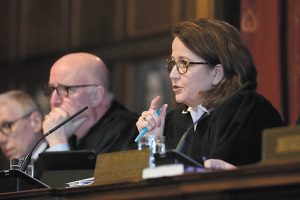Subscriber Benefit
As a subscriber you can listen to articles at work, in the car, or while you work out. Subscribe NowAfter a whirlwind of judicial and legislative activity, Hoosiers could soon have resolution on the question of abortion in Indiana.
The Indiana Supreme Court is currently considering a constitutional challenge to Senate Enrolled Act 1, which prohibits abortion in the state with narrow exceptions. The court heard arguments in the case last month after granting emergency transfer.
Now, Hoosiers wait for a decision.
In the meantime, both sides of the abortion debate are speculating about what might happen after the high court’s ruling. While the opposing sides have decidedly different views on the constitutionality question, they find common ground in one way: Regardless of how the justices rule, the fight over abortion access in Indiana will not be over.
Constitutional question
The case of Members of the Medical Licensing Board of Indiana, et al. v. Planned Parenthood Great Northwest, Hawai’i, Alaska, Indiana, Kentucky, Inc., et al., 22S-PL-338, focuses on one central question: Does Article 1, Section 1 of the Indiana Constitution protect the right to an abortion?
In September 2022, a trial court judge essentially answered that question with a “no” when she enjoined SEA 1.
SEA 1 allows abortions only in cases of rape and incest within certain time limits, fatal fetal anomaly or to protect the health of the mother. One week after the law took effect, Special Judge Kelsey Hanlon determined it violated Article 1, Section 1, which includes a right to “liberty.”

But Indiana Solicitor General Thomas M. Fisher pushed back on that ruling before the justices on Jan. 19, arguing that Article 1, Section 1 does not create a judicially enforceable right. Speaking to reporters after the arguments, Fisher said Article 1, Section 1 establishes that Indiana citizens have rights apart from the state — in other words, rights that are inherent and not given through the state.
“Our position is that there would be no limit to what judges might personally think ought to be included as a fundamental right if all they’re doing is using the word ‘liberty’ in Article 1, Section 1 to carry out those preferences,” he told reporters.
Conversely, Ken Falk, legal director for the American Civil Liberties Union of Indiana, which is representing the plaintiffs, maintained during the arguments that “liberty” has a definable meaning that includes a person’s right to manage the most personal aspects of their lives — including deciding when and if to have a child.

“I think this whole question following Dobbs is whether states have some constitutional provision which protects the fundamental liberty interests, which incorporates a woman’s right to decide concerning procreative matters,” Falk told reporters, referencing the U.S. Supreme Court ruling in Dobbs v. Jackson Women’s Health Organization. “When you talk about a liberty interest, our constitution has a specific provision which guarantees liberty. That’s Article 1, Section 1.”
Substantive vs. procedural
Each of the five justices asked wide-ranging questions of both sides that touched on both procedural and substantive issues.
Chief Justice Loretta Rush grappled with how the Supreme Court could rule given that the appeal is from a preliminary injunction, not a merits decision. Would a decision from the justices be a decision on the constitutionality of SEA 1?
Fisher answered that question affirmatively, telling Rush that when SEA 1 was struck down, the trial court determined the law was unconstitutional. Thus, a Supreme Court reversal would be the same as saying the law is, in fact, constitutional.
Following up, Rush asked whether the case could be remanded for trial. Fisher said he didn’t know what issues would be litigated at trial, because the core issue of the case is the constitutional of SEA 1.

While Falk didn’t face the same line of questioning during arguments, he told reporters he agreed with the assessment that the main issue is the constitutionality question.
Among the questions Falk did face was one from Justice Geoffrey Slaughter on the issue of standing given that the plaintiffs are abortion providers, not pregnant women.
Falk maintained his clients do have standing via an injury: the criminal penalties providers will face if they violate the abortion ban. He also asserted third-party standing and public standing, pointing to Clinic for Women, Inc. v. Brizzi, 837 N.E.2d 973 (Ind. 2005), to support the former. Speaking to reporters, Falk said Brizzi implicitly recognized third-party standing for abortion providers.
One seeming point of common ground was the right of a woman to have an abortion when her own life is in danger. Fisher told reporters that historically, governments have not prohibited abortions when a woman’s life is in danger, including in SEA 1.
With that agreement in mind, Justice Derek Molter questioned why the lawsuit was a facial challenge, rather than an as-applied challenge or a challenge to specific provisions of SEA 1. He specifically asked whether the law could be enjoined only as far as it limits a woman’s right to end a pregnancy to save her own life.
Fisher told the justice there had been no presentation on that issue, and Slaughter chimed in to add that SEA 1 already includes a life-of-the-mother exception.
Molter gave a different example when questioning Falk. The justice pointed to the case of Burwell v. Hobby Lobby, which challenged the mandate in the Affordable Care Act that required employers to provide health care coverage for contraceptives.
Describing the ACA as a “massive” piece of legislation, Molter asked Falk if the entirety of the law could have been struck down based only on the contraceptive coverage challenge. Falk said no, but he said the Indiana Supreme Court could narrow the scope of the injunction in its final ruling in the instant case.
What’s next?
Both sides provided time-based references for what would happen if the Supreme Court ruled in their favor.

For the state, Fisher said a reversal of the injunction would return the state of the law to pre-Roe v. Wade.
Conversely, Falk said upholding the injunction would restore the “status quo” that had been in place before SEA 1 took effect Sept. 15. That would mean abortion would be legal up to 20 weeks — the current state of the law while the injunction remains in place.
Asked by reporters what would happen if the high court lets SEA 1 take effect again, Falk said it was “hard to evaluate” what the next steps would be.
Falk did point to a second challenge to SEA 1 on religious freedom grounds. In that case, the Marion Superior Court struck down the law as a violation of the state’s Religious Freedom Restoration Act, so the state is once again seeking emergency transfer to the Supreme Court.
The plaintiffs also raised an equal privileges and immunities claim under Article 1, Section 23 of the Indiana Constitution, but the trial court declined to enter an injunction on that ground and the plaintiffs did not appeal. Falk and Fisher each acknowledged that the Section 23 claim is still waiting in the trial court, but Falk said the focus for now is on Article 1, Section 1.
As for stakeholders, Rebecca Gibron, CEO of Planned Parenthood Great Northwest, maintained that even if SEA 1 is allowed to take effect, Planned Parenthood clinics in Indiana will not be closing.
“We absolutely are going nowhere,” she told reporters after the arguments. “… We are not turning our backs on our patients the way extreme Indiana lawmakers have.”
But Indiana Attorney General Todd Rokita, a staunchly anti-abortion Republican, has vowed to continue his fight against “pro-abortion extremists.”
“They now make the baseless claim, for example, that our own Indiana Constitution somehow protects abortion,” Rokita said in a video posted to his official YouTube channel on Jan. 18. “But rest assured that we will keep fighting for the precious right to life and the proper interpretation of our constitutions.”•
Please enable JavaScript to view this content.
